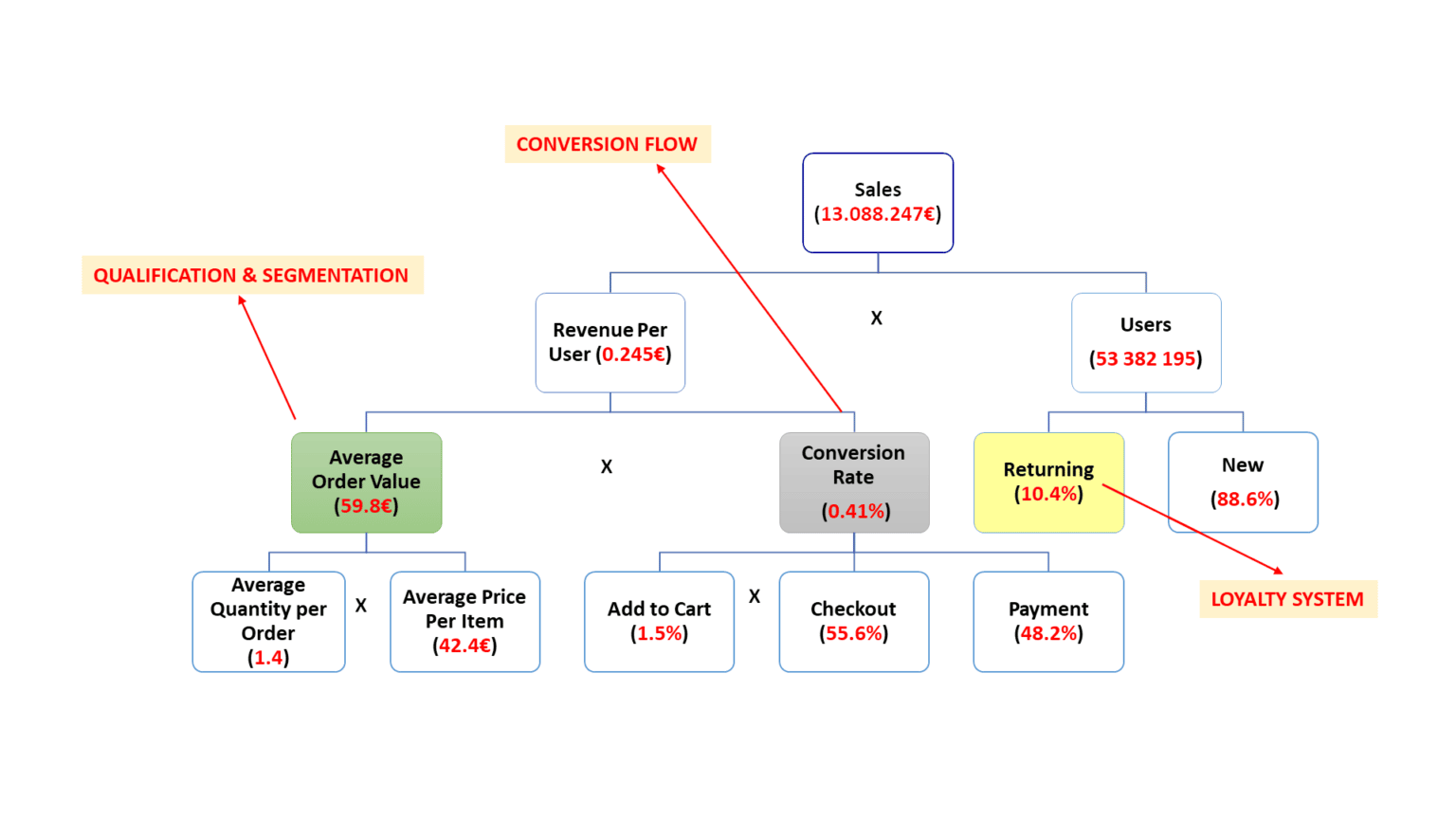How to Grow Ecommerce Sales – Best Strategy
Are you looking to accelerate your Ecommerce Business? Here is your complete guide on how to select the best strategy to do that. Here, you will NOT find any recipes, or 101 best tactics or similar stuff. Instead, we will show you where, why and how to start intervening in order to define your best strategy or path, to grow your specific online store results.

Introduction - What is the best strategy to increase sales of my online store?

This is a simple problem and perhaps the most common, for those who do business online, namely in the context of B2C (which is substantially different from the B2B business).
Being in fact an amazingly simple question, sometimes it has a somewhat complex solution and the best strategy, to improve the results of your ecommerce project, is not always the most evident and visible.
From my experience, I imagine that the overwhelming majority of professionals (80%? 90%? – anyway, this are not official statistics, but only my perception) would say that the solution is to go immediatly prepare some get traffic- campaign on Google Ads, or Social Media or send a few thousand emails from any database (if acquired somewhere on the internet -not recommended), or any other similar solution.
What do these solutions have in common? – They are solutions oriented mainly to the creation of traffic. I will refrain from commenting in detail on each of these potential solutions, on their advantages and disadvantages, and I will assume (for the time being) that they are all perfectly viable.
However, let me embark on another type of analysis – before moving on to the solution now – please, allow me to step back a little and try to answer two of the most obvious questions, which you will certainly ask yourself, in the face of the context:
- What is the biggest problem with my store sales?
- Where should I start solving?
With a good analysis, I intend to show you, in a quite simple way, the bases for you to:
- identify the most relevant problem
- define the strategy to improve the results and sales of your online store
- define the objectives appropriate to that strategy
The basics of your online business and the strategy for your digital marketing
For the sake of simplification, I will only assume the case of ecommerce, but this example can be extended to any type of business, obviously safeguarding the due and necessary adaptations to the model.
Let me simplify the model of your ecommerce business, presenting a very simple, obvious and a lapalissade solution.
In ecommerce, doesn’t matter how many frameworks, techniques, trends, designs, social media networks, terminologies or tools appear daily, because the absolute truth is that it all comes down to:
Simply put, there are two general strategies for generating business: getting traffic and converting that traffic into business. Unfortunately, most professionals and entrepreneurs only think about getting traffic when it comes to digital marketing and ecommerce strategy.
Don’t get me wrong – having traffic (especially if it is qualified and high quality) is absolutely vital to generate business, but… it is just one of the fundamental variables – the other is to optimize this traffic, that is, convert it into business, in a sustainable way . There is no advantage in having visits to the store if nothing happens afterwards…
Yeah… You want to increase sales on your online store, right? The first thing to do is to identify in which of the variables lies the biggest problem. Is it in the amount of traffic, or in your conversion processes?
Your starting (and arrival) model
So, let’s go to the example with purely fictitious data. For this purpose, I will consider the following analysis model (note: Your Google Analytics account must be prepared for receiving and processing this kind of data):

The problems of your online store - the analysis
Note that each of the variables can be decomposed into two sub-variables, which when combined, produce the final result. The important thing to remember is that as we move down the hierarchy of variables, we will somehow define the main levers where we must effectively move to improve the business.
In fact, each of them corresponds to a different tactic (and a problem or goal), based on the same final objective.
I have pointed out with different colors, some of the variables, just to highlight the type of different tactic that is implied. For example:
- Yellow – Customer Loyalty System
- Green – Customer Qualification and Segmentation system
- Gray – Conversion Processes
Each of these systems and box represents a part of the entire process and has its own relevant tactics to improve results: cross-selling, up-selling, conversion optimization, traffic generation, etc… are all different tactics with differentiated objectives and outcomes, many times with opposite effects.
For example, if you change your Google Ads campaigns to attract more/different traffic, you may be going after alternative segments, tending to consume less of your product, thus lowering your average order value. This means you may end up spending money, and getting the same final results.
By implementing and using this model, year after year, you will be able to identify which global aspects of your strategy should be reviewed and improved. Whether comparing with similar indicators from the past or with indicators from your business sector, you can build a picture of the main performance variables of your ecommerce and where are the biggest problems.
What is the strategy? And what are the objectives?
What is the main path? Generate traffic or optimize it? In the model I present you, these 2 main paths are represented by the 2 main sub-variables. For example, if you decide that the best alternative is to increase visits, then your focus should be divided into 2 different tactics:
- Focus on generating new visits, or
- Increasing loyalty of current users
Let’s assume that you decide to increase visits? Google Ads, Social Media Advertising, Display Advertising, Low Cost Traffic, etc…
Taking the previous fictitious example, if nothing changes in the store structure or the type of customer, an increase of 1,000,000 users is expected to produce additional sales in the order of € 245,000, right?
Let’s assume that that you decide to focus energy (and investment) on a Google Ads lead generation campaign. Imagine that, for example, each click costs you an average of € 0.15. That means you will spend about 150,000€ to reach your target of 1,000,000 visits and 245,000€ in sales.
The same type of analysis in relation to the other channels. In practice, what you should ask yourself is: how much does it cost me to acquire these visits needed? And of course, you should also include in this analysis, regardless of the type of costs: human resources, content creation, etc…
On the other hand, continuing with the same example, what if your chosen strategy involves optimizing processes on your ecommerce website? What if you suddenly manage to increase revenue per visitor by 2% or 0.005€? So, additional sales will also be 245.000€, but… without spending 150,000€ on new traffic.
Now, the question is: how to do it? The answer is: developing conversion optimization processes, implementing up-selling and cross-selling tactics, among others.
And how much does this approach costs you? Probably a lot less than the “only traffic” previous one, and with one major advantage – those optimized processes will perpetuate on time (not forever really, but a nice assumption 😊).
So, what is the best approach? Which one makes the most sense?
I would say that there is no universal recipe – this is mainly a matter of common sense, considering the analysis of:
- Trend – what values have been getting worse?
- Potential – which area has the greatest earning potential?
- Ease – what is the easiest strategy to implement (for example at the level of investment required)?
Of course, probably the best strategy has a little bit of all. The potential effects of improvements in several of the variables at the same time, can be absolutely fantastic.
From the combination of these analyses (and other eventual ones), the answer to the questions will be born:
- What is the biggest problem?
- What is the solution?
Only then, we will then move on from:
- How to do it?
- How to implement the strategy?
It is only at this stage that we should evaluate each of the options initially presented.
Of course, to carry out an analysis of this type, it is absolutely essential that you have the indicators available, isn’t it? Having an Analytics account set up and prepared to provide this type of answers (and more complex ones) should be the first task of managing your online store.
So, in your specific case, do you have any idea? Do you already have know-how in your team to do this? Let’s improve your ecommerce?







